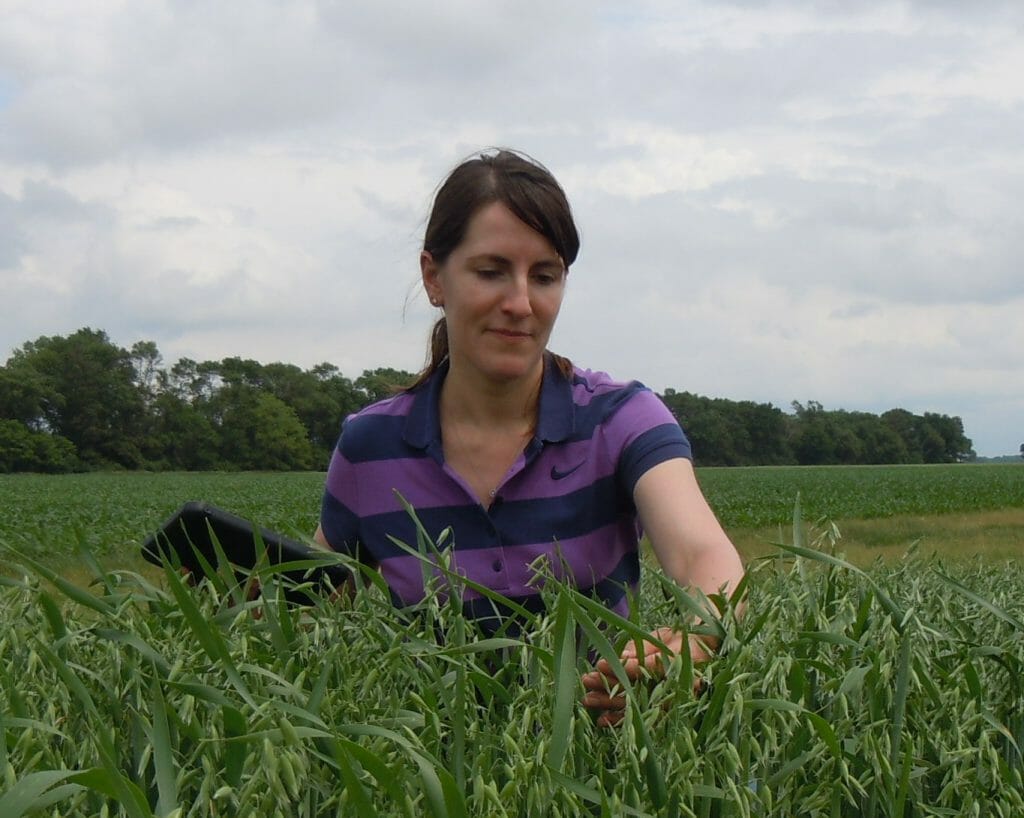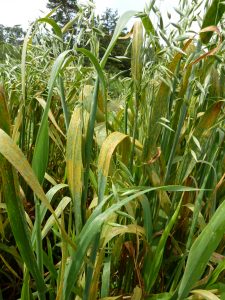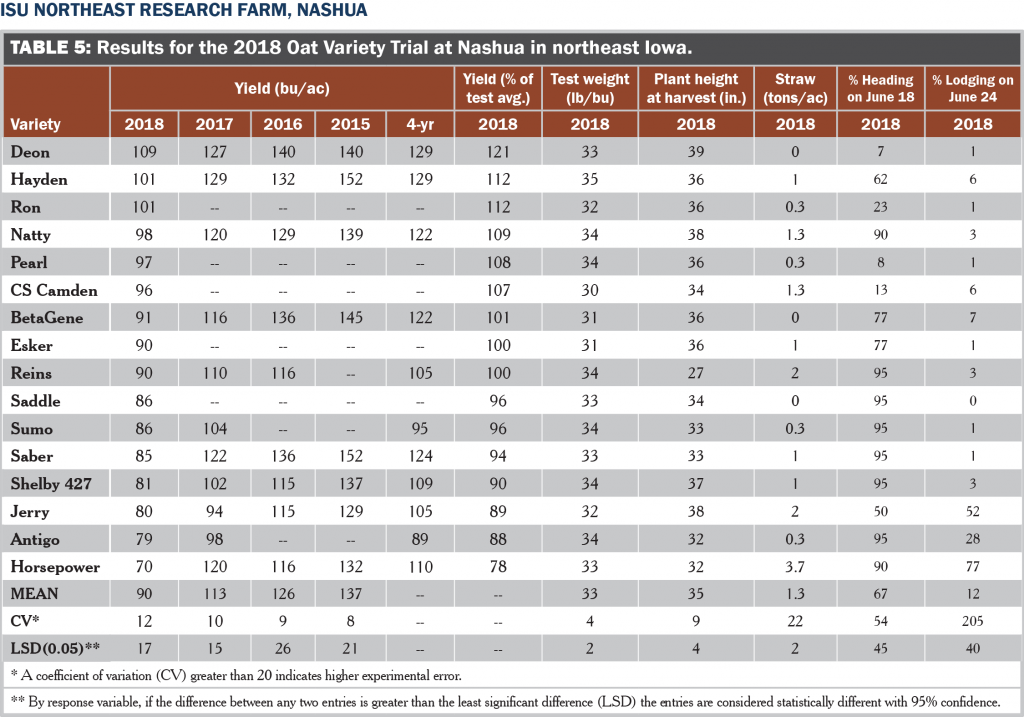Winnowing Down Oat Variety Trial Results
Variety selection for any crop is a critical choice that can affect input costs and yields down the line. Unfortunately, variety trial data on oats is not nearly as abundant as trial data from crops such as corn and soybeans and the format of this information is, frankly, not as useful for quickly and easily choosing a variety suited to the conditions on a particular farm. To help us wade through this data we invited oat breeder Melanie Caffe from South Dakota State University on our February shared learning call where we dug into oat variety selection.

Melanie Caffe is a South Dakota State University oat breeder, she joined PFI’s February shared learning call to discuss selecting oat varieties.
Step 1 – Gather trial data
“Use as much information as possible,” Melanie says. “Put more weight on the information that is close to your farm, but don’t just look at the location next to your farm. Look at the performance of the variety over many locations because it will indicate how well the variety adapts to different conditions.”
In addition to looking at multiple trial locations, it’s also important to look at multiple trial years. “When we have a year like 2018 that was notably poorer growing conditions than usual, looking at just 2018 data would give you a very different expectation than a normal year,” Melanie says. “Most universities publish yearly results but also three and four year averages. Look at these averages to avoid weighing extreme years too much.”
Here are the most up-to-date oat variety trial results for the upper Midwest:
- ISU Oat Variety Trials : 2012 – 2013 – 2014 – 2015ne – 2015nc
- Illinois Wheat and oat Variety Trials
- University of Minnesota Oat Variety Trials
- Practical Farmers of Iowa Oat Variety Trial: 2015 – 2016 – 2017 – 2018
- North Dakota State University Oat Variety Trails
- South Dakota State University 2003-2017 – 2018
- University of Wisconsin 2016 – 2017 – 2018

An oat variety trial planting at Kanawha research station in 2017.
Step 2 – Use market destination to focus selection criteria
“Consider the market end use,” Melanie says. “Talk to the buyer ahead of time to determine what their desired qualities are.” If you’re planning to take your oats as oatlage you are looking for completely different characteristics than if you are planning to sell to a mill. Mills that buy food grade oats have requirements for test weight so that is going to be one of the key variables on the trial data that you look at whereas biomass is the most important for forage production so you’ll want to pay more attention to the plant height information. If you are planning to use oat grain as feed for animals then your highest priorities are going to be yield and disease resistance to avoid mycotoxin contamination of the feed. If you are hoping to sell oats for cover crop seed then you will need to select varieties that are no longer covered by Plant Variety Protection or you’ll need to go through the proper processes to sell a newer, protected variety (read more about this in my seed law blog).
| Market or End Use | Weighted Characteristics |
| Food grade milling grain | Test weight |
| Feed grade grain | Yield |
| Oatlage | Plant height |
| Cover crop seed | Intellectual property protections by variety |
While some characteristics should be weighted more than others due to the end market, it’s important to take a look at all of the data points before making a final selection. Disease resistance and lodging, for instance are important factors in selecting a variety for any end use because they will significantly impact management costs and time.
Step 3 – Dig into the statistics
“Pay attention to statistical difference in yields, not just the yield number,” Melanie says. Statistics may seem daunting, but with a little know-how these can be very helpful elements of variety trial data to make your decision. Most variety trial results will list two statistical indicators – Least Significant Difference (LSD) and Coefficient of Variation (CV).
LSD is a measure that allows you to compare varieties to each other to see if the yields (or another characteristic) is different enough that it’s likely you’ll see that difference play out again in your field. For example, in the 2018 Practical Farmers’ trial at Nashua the LSD was 17. Horsepower yielded 70 and Hayden yielded 101 bushels per acre – the difference in their yields of 31 was greater than the LSD of 17. So we can say with 95 percent confidence that Hayden would yield better than Horsepower.
CV is a measure of variability or experimental error, essentially the confidence that the performance outcomes resulted from actual varietal characteristics rather than a flaw in the experiment or management. Lower numbers are better here, indicating a lower possibility that the results were obtained through error. Less than 10 is an excellent confidence level, 15 percent or less is desirable and 20 or higher indicates high chance of experimental error. Continuing the example from the Practical Farmers’ example at Nashua, we see that the 2018 yields had a CV of 12 percent so this we can be reasonably confident that these results are due to varietal characteristics.
Step 4 – Look at trial management
By properly weighing and unpacking the statistics from trial results close to your farm and the key characteristics important for your end market, a handful of varieties have probably risen to the top as likely candidates. Before making your final selection, look at whether fungicides were applied in the trial or not. Fungicides can boost yields but may not be desirable in your management plan for your oat crop. Compare yields for that variety among trials that use fungicides and those that don’t to get a sense for which varieties perform to your desired level without fungicides and you’re more likely to be satisfied with your outcomes.
Keep in mind that if you have high disease pressure on your farm you’ll want to select varieties that are rated as resistant or moderately resistant to your key diseases of concern. But take these rankings with a grain of salt, “Disease resistance breaks down over time as the varieties have been released,” Melanie explains. So an eight-year-old variety rated resistant at its release is probably only moderately resistant or moderately susceptible today. Selecting a variety with good disease resistance can be a game changer for ROI on your oat crop as you may be able to avoid spraying with a resistant variety.

Oats infected with crown rust.
You may also want to look at whether trial sites were managed with fertilizer applications, tillage or other practices. Similar conditions to those you practice in your management are more likely to yield similar results. For considering management, the trial results around plant height and lodging are most important. If a variety is already very tall and has high lodging in a trial with no fertilizer and you plan to fertilize you may need apply a growth regulator, skip the fertilizer or be prepared to handle lodging during harvest. If you have equipment or harvest plans that would mean lodging is not a large concern, then it’s not as important.
Finally, keep in mind that maturity ratings for oats are counter intuitive. Oats love cold weather. The farther south you are and the hotter your climate is the sooner the oat will want to be out of the field. So early maturing varieties are better suited to hotter, southern locations while late maturing varieties are better suited to northern, colder locations. However, it’s not an exact science. “There are some years where you think an early maturing variety would do best, but it’s more favorable to a late maturing variety,” Melanie says. “I would suggest, if you’re planting enough acres, plant two varieties – one early maturing and one late maturing.” If you are establishing an underseeding of alfalfa or clover under your oats, then you will want to stick with early maturing varieties.
Melanie concluded with some thoughts on her favorite new varieties of oats coming out of her program – summarized in the table below. Not sure how much seed to buy now that you’ve selected your variety? Check out our calibrate to populate video from our rotationally raised series or this handbook on oat production from Grain Millers. For more information about our small grains programming visit our small grains page or sign up to receive timely small grains announcements and resources straight to your email inbox in a monthly newsletter.
| Variety | Description |
| Hayden | High yield, high stability and test weight. Moderately susceptible to crown rust so fungicide application recommended at flag leaf stage |
| Natty | A newer variety to replace Shelby 427, high test weight and yield compared to Shelby 427, however not super resistant to crown rust and low in beta glucan so it’s not on the recommended list for the milling industry |
| Saddle | A newer variety to replace horsepower, acceptable for milling quality |
| Goliath | Good for forage, biggest biomass |
| Deon | Good high-yielding variety with crown rust resistance |

